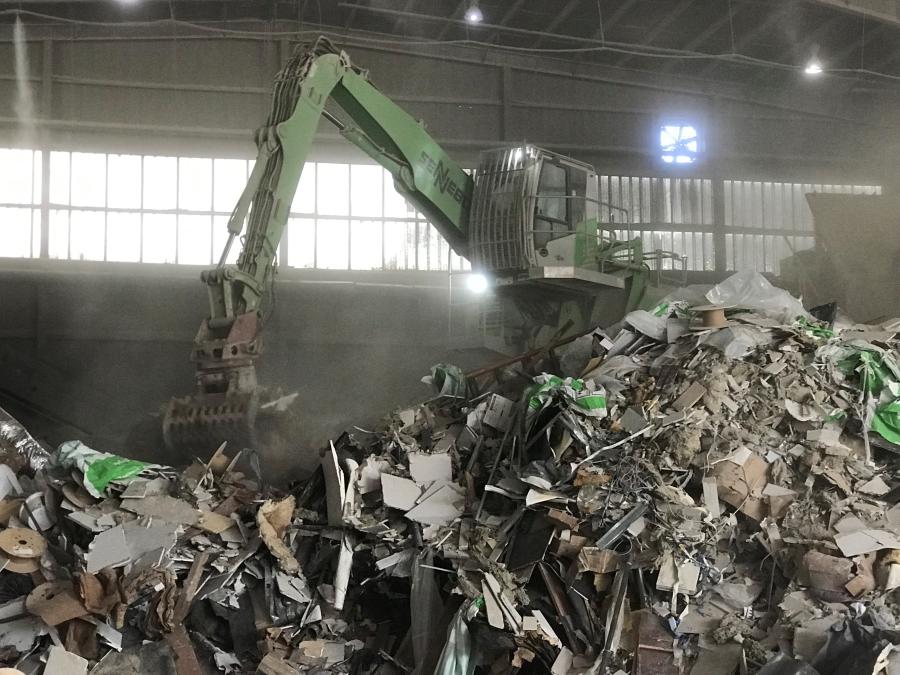
Thu December 10, 2020
Sennebogen
In some equipment fleets, preventive maintenance is a periodic afterthought. At Sun Services LLC, it's a full time job.
Averaging 70 tons or more of construction and demolition debris to receive, process and ship every hour of its working day, Sun's recycling facility can't spare a minute for downtime.
When the Sun Services site was first designed, it was targeted for a capacity of 400 tons per day. To meet customer demand in Washington D.C.'s Beltway district, Brian Shipp, one of the founders, streamlined their receiving bays and upgraded their waste handling machines to double their volume.
Same-Day Cycles
According to Shipp, "Everything that comes in here has to go out the same day. We only have 250 cu. yards of metal storage onsite and two bunkers for concrete."
Operating a large truck fleet, including roll-offs and large walking floor trailers, the compact facility is now taking on peak traffic of up to 60 trucks in one hour. Their shredder line simply cannot stop.
But the under-roof facility is a hot, dirty, dusty place for equipment to live and work in. No machine can be expected to keep up the pace without full-time attention. Sun's loading equipment reflects that harsh reality.
Sun started out with a conventional fleet of wheel loaders and excavators, but those machines could not keep up with the growing demand. In early 2019, Shipp acquired his first purpose-built Sennebogen 818 waste handler from Midlantic Machinery.
After seeing it perform, they added two more 818s later that year. But only two of the new machines are operating at any given time. That's the core of Sun's full-time PM plan.
Bench Strength
To ensure that each machine gets the service attention it needs to perform on demand, Sun keeps two units on the job, with another on the bench.
"One 818 sits on top of the pile and feeds the shredder. While the shredder is processing, the loader can pre-sort oversize items out of the stream, such as big concrete, metal, cable, tanker vessels. Another 818 sits at the other end of the stream, loading out residual material."
While two of the 818s handle the workload of the 10-hour day, the third unit is getting serviced.
"Our machines look terrible at the end of a week-long shift." Shipp said. "We rotate out one of the machines so it can get a thorough cleaning. We'll do two or three rotations between scheduled maintenance intervals."
The Sennebogen machines are all equipped with hydraulic reversing fans. Shipp said they pause a few times each day to run the fans and clear the cooling system, then they dig into the piles once more.
Ongoing Factory Service
Meanwhile, factory-trained technicians from Midlantic are routinely onsite to maintain and inspect one of the waste handlers.
"Any gremlins we have had, Midlantic figured it out quickly."
On the next rotation cycle, the technicians apply any adjustments they made to the other two machines, to prevent the same problem from coming up again. Sun signed on for Midlantic's service plans, and Sennebogen's built-in Sencon software keeps Midlantic aware of the machines' service needs.
The capabilities of the purpose-built material handlers also helped Sun to expand its capacity. The 818's responsive hydraulics and agile grapple allow a single machine to pre-sort material while it keeps the shredder fed and producing. Due to Sun's efficiency in reclaiming material, the firm is able to offer LEED credits for customer projects.
Safe and Productive
The Sennebogen hydraulic Maxcab rises to 18 ft. and gives operators a clear view for fast, efficient loading into the shredder and load-out trucks. The cab is comfortable and a safe work space in an environment that doesn't allow them to keep doors open.
"They're big guys," said Shipp. "But the cab gives them the room they need; the AC keeps up with the heat, and we've seen that it gives them good protection from falling debris."
With 4,000 hours on the original 818 and about 3,000 hours for the other two, Shipp said Sennebogen was the right choice.
"They have been exponentially better than excavators we used previously," Shipp said. "We're very happy with them. When it comes time to open our next plant, we plan to build our fleet with Sennebogen when the time comes."
For more information, visit www.sennebogen-na.com.

Equipped with tracks, the operator can safely get to the top of the pile and with the cab raised, has a clear field of vision.
 Aggregate Equipment
Aggregate Equipment Articles
Articles Sign up for Updates
Sign up for Updates Sell Your Machines
Sell Your Machines

 Aggregate Equipment
Aggregate Equipment Aggregate Dealers
Aggregate Dealers Aggregate Articles
Aggregate Articles Sign up for Updates
Sign up for Updates Sell Your Machines
Sell Your Machines